Current Progress and Future Trends in Carbon Sources and Sinks in Farmland Ecosystems: A Bibliometric Analysis (2002–2023)
Simple Summary
Abstract
1. Introduction
2. Materials and Methods
3. Results and Discussion
3.1. Characteristics of the Publications
3.2. Publication Output Analysis
3.3. Analysis by Author, Institution, Country (Region), and Subject Area
3.4. Research Theme Analysis
3.4.1. Study on Soil Organic Carbon Sequestration Mechanisms
3.4.2. Research on Greenhouse Gas Monitoring and Estimation
3.4.3. Research on Ecosystem Services
3.4.4. Spatiotemporal Evolution and Driving Factors of Carbon Sources and Sinks in Farmland Ecosystems
3.5. Research Hotspot Evolution and Trend Analysis
3.5.1. Research Hotspot Evolution Analysis
3.5.2. Research Fronts and Research Trends
4. Future Research Directions
5. Conclusions
Author Contributions
Funding
Data Availability Statement
Acknowledgments
Conflicts of Interest
Abbreviations
| SOC | Soil organic carbon |
| GHG | Greenhouse gas |
| GIS | Geographical Information System |
| NPP | Net primary productivity |
| WOS | Web of Science |
| WOSCC | Web of Science Core Collection |
| SSCI | Social Sciences Citation Index |
| SCI-EXPANDED | Science Citation Index Expanded |
| SOM | Soil organic matter |
| iPOM | Intra-aggregate particulate organic matter |
| MCP | Microbial carbon pump |
| MnCP | Soil mineral carbon pump |
| CRP | Conservation Reserve Program |
| GC | Gas chromatography |
References
- Fang, J.; Yu, G.; Liu, L.; Hu, S.; Chapin, F.S. Climate Change, Human Impacts, and Carbon Sequestration in China. Proc. Natl. Acad. Sci. USA 2018, 115, 4015–4020. [Google Scholar] [CrossRef]
- Della Chiesa, T.; Northrup, D.; Miguez, F.E.; Archontoulis, S.V.; Baum, M.E.; Venterea, R.T.; Emmett, B.D.; Malone, R.W.; Iqbal, J.; Necpalova, M.; et al. Reducing Greenhouse Gas Emissions from North American Soybean Production. Nat. Sustain. 2024, 7, 1608–1615. [Google Scholar] [CrossRef]
- Jobbágy, E.G.; Jackson, R.B. The Vertical Distribution of Soil Organic Carbon and Its Relation to Climate and Vegetation. Ecol. Appl. 2000, 10, 423–436. [Google Scholar] [CrossRef]
- Intergovernmental Panel on Climate Change (IPCC) (Ed.) Land–Climate Interactions. In Climate Change and Land: IPCC Special Report on Climate Change, Desertification, Land Degradation, Sustainable Land Management, Food Security, and Greenhouse Gas Fluxes in Terrestrial Ecosystems; Cambridge University Press: Cambridge, UK, 2022; pp. 131–248. [Google Scholar]
- Lal, R. Soil Carbon Sequestration Impacts on Global Climate Change and Food Security. Science 2004, 304, 1623–1627. [Google Scholar] [CrossRef] [PubMed]
- Yang, Y.H.; Shi, Y.; Sun, W.J.; Chang, J.F.; Zhu, J.X.; Chen, L.Y.; Wang, X.; Guo, Y.P.; Zhang, H.T.; Yu, L.F.; et al. Trestrial carbon sinks in China and around the world and their contribution to carbon neutrality. Sci. Sin. 2022, 52, 534–574. [Google Scholar] [CrossRef]
- Clune, S.; Crossin, E.; Verghese, K. Systematic Review of Greenhouse Gas Emissions for Different Fresh Food Categories. J. Clean. Prod. 2017, 140, 766–783. [Google Scholar] [CrossRef]
- Lal, R. Global Potential of Soil Carbon Sequestration to Mitigate the Greenhouse Effect. Crit. Rev. Plant Sci. 2003, 22, 151. [Google Scholar] [CrossRef]
- West, T.O.; Marland, G. Net Carbon Flux from Agricultural Ecosystems: Methodology for Full Carbon Cycle Analyses. Environ. Pollut. 2002, 116, 439–444. [Google Scholar] [CrossRef]
- Jiang, Z.; Zhong, Y.; Yang, J.; Wu, Y.; Li, H.; Zheng, L. Effect of Nitrogen Fertilizer Rates on Carbon Footprint and Ecosystem Service of Carbon Sequestration in Rice Production. Sci. Total Environ. 2019, 670, 210–217. [Google Scholar] [CrossRef]
- Wei, H.; Wu, L.; Chen, D.; Yang, D.; Du, J.; Xu, Y.; Jia, J. Rapid Climate Changes Responsible for Increased Net Global Cropland Carbon Sink during the Last 40 Years. Ecol. Indic. 2024, 166, 112465. [Google Scholar] [CrossRef]
- Li, H.; Jin, X.; Zhao, R.; Han, B.; Zhou, Y.; Tittonell, P. Assessing Uncertainties and Discrepancies in Agricultural Greenhouse Gas Emissions Estimation in China: A Comprehensive Review. Environ. Impact Assess. Rev. 2024, 106, 107498. [Google Scholar] [CrossRef]
- Liu, X.; Wang, S.; Zhuang, Q.; Jin, X.; Bian, Z.; Zhou, M.; Meng, Z.; Han, C.; Guo, X.; Jin, W.; et al. A Review on Carbon Source and Sink in Arable Land Ecosystems. Land 2022, 11, 580. [Google Scholar] [CrossRef]
- Li, M.; Peng, J.; Lu, Z.; Zhu, P. Research Progress on Carbon Sources and Sinks of Farmland Ecosystems. Resour. Environ. Sustain. 2023, 11, 100099. [Google Scholar] [CrossRef]
- Chen, C.; Song, M. Visualizing a Field of Research: A Methodology of Systematic Scientometric Reviews. PLoS ONE 2019, 14, e0223994. [Google Scholar] [CrossRef]
- Chen, C. CiteSpace II: Detecting and Visualizing Emerging Trends and Transient Patterns in Scientific Literature. J. Am. Soc. Inf. Sci. Technol. 2006, 57, 359–377. [Google Scholar] [CrossRef]
- Van Eck, N.J.; Waltman, L. Software Survey: VOSviewer, a Computer Program for Bibliometric Mapping. Scientometrics 2010, 84, 523–538. [Google Scholar] [CrossRef] [PubMed]
- Zheng, X.; Lu, Y.; Yuan, J.; Baninla, Y.; Zhang, S.; Stenseth, N.C.; Hessen, D.O.; Tian, H.; Obersteiner, M.; Chen, D. Drivers of Change in China’s Energy-Related CO2 Emissions. Proc. Natl. Acad. Sci. USA 2020, 117, 29–36. [Google Scholar] [CrossRef]
- Ledford, H. How to Solve the World’s Biggest Problems. Nature 2015, 525, 308–311. [Google Scholar] [CrossRef]
- Okamura, K. Interdisciplinarity Revisited: Evidence for Research Impact and Dynamism. Palgrave Commun. 2019, 5, 141. [Google Scholar] [CrossRef]
- Xie, H.; Wen, Y.; Choi, Y.; Zhang, X. Global Trends on Food Security Research: A Bibliometric Analysis. Land 2021, 10, 119. [Google Scholar] [CrossRef]
- Don, A.; Steinberg, B.; Schöning, I.; Pritsch, K.; Joschko, M.; Gleixner, G.; Schulze, E.-D. Organic Carbon Sequestration in Earthworm Burrows. Soil Biol. Biochem. 2008, 40, 1803–1812. [Google Scholar] [CrossRef]
- Beillouin, D.; Corbeels, M.; Demenois, J.; Berre, D.; Boyer, A.; Fallot, A.; Feder, F.; Cardinael, R. A Global Meta-Analysis of Soil Organic Carbon in the Anthropocene. Nat. Commun. 2023, 14, 3700. [Google Scholar] [CrossRef] [PubMed]
- Rumpel, C.; Kögel-Knabner, I. Deep Soil Organic Matter—A Key but Poorly Understood Component of Terrestrial C Cycle. Plant Soil 2011, 338, 143–158. [Google Scholar] [CrossRef]
- Poeplau, C.; Don, A.; Vesterdal, L.; Leifeld, J.; Van Wesemael, B.; Schumacher, J.; Gensior, A. Temporal Dynamics of Soil Organic Carbon after Land-Use Change in the Temperate Zone–Carbon Response Functions as a Model Approach. Glob. Change Biol. 2011, 17, 2415–2427. [Google Scholar] [CrossRef]
- Feng, W.; Shi, Z.; Jiang, J.; Xia, J.; Liang, J.; Zhou, J.; Luo, Y. Methodological Uncertainty in Estimating Carbon Turnover Times of Soil Fractions. Soil Biol. Biochem. 2016, 100, 118–124. [Google Scholar] [CrossRef]
- Huang, Y.; Lu, X.; Shi, Z.; Lawrence, D.; Koven, C.D.; Xia, J.; Du, Z.; Kluzek, E.; Luo, Y. Matrix Approach to Land Carbon Cycle Modeling: A Case Study with the Community Land Model. Glob. Change Biol. 2018, 24, 1394–1404. [Google Scholar] [CrossRef]
- Six, J.; Bossuyt, H.; Degryze, S.; Denef, K. A History of Research on the Link between (Micro)Aggregates, Soil Biota, and Soil Organic Matter Dynamics. Soil Tillage Res. 2004, 79, 7–31. [Google Scholar] [CrossRef]
- Six, J.; Elliott, E.T.; Paustian, K. Soil Macroaggregate Turnover and Microaggregate Formation: A Mechanism for C Sequestration under No-Tillage Agriculture. Soil Biol. Biochem. 2000, 32, 2099–2103. [Google Scholar] [CrossRef]
- Christensen, B.T. Physical Fractionation of Soil and Structural and Functional Complexity in Organic Matter Turnover. Eur. J. Soil Sci. 2001, 52, 345–353. [Google Scholar] [CrossRef]
- Oglesby, R.T.; Christman, R.F.; Driver, C.H. The Biotransformation of Lignin to Humus—Facts and Postulates. Adv. Appl. Microbiol. 1968, 9, 171–184. [Google Scholar] [CrossRef]
- Liang, C.; Schimel, J.P.; Jastrow, J.D. The Importance of Anabolism in Microbial Control over Soil Carbon Storage. Nat. Microbiol. 2017, 2, 17105. [Google Scholar] [CrossRef]
- Xiao, K.Q.; Zhao, Y.; Liang, C.; Zhao, M.; Moore, O.W.; Otero-Fariña, A.; Zhu, Y.G.; Johnson, K.; Peacock, C.L. Introducing the Soil Mineral Carbon Pump. Nat. Rev. Earth Environ. 2023, 4, 135–136. [Google Scholar] [CrossRef]
- Liao, Q.; Zhang, X.; Li, Z.; Pan, G.; Smith, P.; Jin, Y.; Wu, X. Increase in Soil Organic Carbon Stock over the Last Two Decades in China’s Jiangsu Province. Glob. Change Biol. 2009, 15, 861–875. [Google Scholar] [CrossRef]
- Triberti, L.; Nastri, A.; Giordani, G.; Comellini, F.; Baldoni, G.; Toderi, G. Can Mineral and Organic Fertilization Help Sequestrate Carbon Dioxide in Cropland? Eur. J. Agron. 2008, 29, 13–20. [Google Scholar] [CrossRef]
- Greene, L.A. United Nations Framework Convention on Climate Change. Environ. Health Perspect. 2000, 108, A353. [Google Scholar] [CrossRef]
- Forte, A.; Fagnano, M.; Fierro, A. Potential Role of Compost and Green Manure Amendment to Mitigate Soil GHGs Emissions in Mediterranean Drip Irrigated Maize Production Systems. J. Environ. Manag. 2017, 192, 68–78. [Google Scholar] [CrossRef]
- Roger, C.; Bowman, M.; McFadden, J.; Smith, D.; Wallander, S. Tillage Intensity and Conservation Cropping in the United States; U.S. Department of Agriculture, Economic Research Service: Washington, DC, USA, 2018; Volume 197, pp. 1–8. Available online: https://www.ers.usda.gov/publications/pub-details/?pubid=90200 (accessed on 19 October 2024).
- Sun, X.; Qian, L.; Cao, Y.; Wang, M.; Li, N.; Pang, R.; Si, T.; Yu, X.; Zhang, X.; Zuza, E.J.; et al. Exploration of the Optimal Low-Carbon Peanut Rotation System in South China. Agric. Syst. 2024, 221, 104145. [Google Scholar] [CrossRef]
- Bhattacharyya, P.; Roy, K.S.; Neogi, S.; Adhya, T.K.; Rao, K.S.; Manna, M.C. Effects of Rice Straw and Nitrogen Fertilization on Greenhouse Gas Emissions and Carbon Storage in Tropical Flooded Soil Planted with Rice. Soil Tillage Res. 2012, 124, 119–130. [Google Scholar] [CrossRef]
- Lugato, E.; Bampa, F.; Panagos, P.; Montanarella, L.; Jones, A. Potential Carbon Sequestration of European Arable Soils Estimated by Modelling a Comprehensive Set of Management Practices. Glob. Change Biol. 2014, 20, 3557–3567. [Google Scholar] [CrossRef]
- Benites, J.R.; Derpsch, R.; McGarry, D. The current Status and Future Growth Potential of Conservation Agriculture in the World Context. In Proceedings of the “Soil Management for Sustainability”, 16th ISTRO Conference, Brisbane, Australia, 13–19 July 2003; pp. 120–129. [Google Scholar]
- Corbeels, M.; Cardinael, R.; Naudin, K.; Guibert, H.; Torquebiau, E. The 4 per 1000 Goal and Soil Carbon Storage under Agroforestry and Conservation Agriculture Systems in Sub-Saharan Africa. Soil Tillage Res. 2019, 188, 16–26. [Google Scholar] [CrossRef]
- Kassam, A.; Friedrich, T.; Derpsch, R. Global Spread of Conservation Agriculture. Int. J. Environ. Stud. 2019, 76, 29–51. [Google Scholar] [CrossRef]
- Friedrich, T.; Derpsch, R.; Kassam, A. Overview of the Global Spread of Conservation Agriculture. Field Actions Sci. Rep. 2012, 76, 29–51. [Google Scholar]
- Ryan, J.; Rashid, A.; Torrent, J.; Yau, S.K.; Ibrikci, H.; Sommer, R.; Erenoglu, E.B. Micronutrient Constraints to Crop Production in the Middle East-West Asia Region: Significance, Research, and Management. Adv. Agron. 2013, 122, 1–84. [Google Scholar] [CrossRef]
- Allmaras, R.R.; Schomberg, H.H. Conservation Tillage Unforeseen Advantage. Resour. Eng. Technol. Sustain. World 1999, 6, 7–8. [Google Scholar]
- Follett, R.F. Soil Management Concepts and Carbon Sequestration in Cropland Soils. Soil Tillage Res. 2001, 61, 77–92. [Google Scholar] [CrossRef]
- Tian, J.; Dungait, J.A.J.; Hou, R.; Deng, Y.; Hartley, I.P.; Yang, Y.; Kuzyakov, Y.; Zhang, F.; Cotrufo, M.F.; Zhou, J. Microbially Mediated Mechanisms Underlie Soil Carbon Accrual by Conservation Agriculture under Decade-Long Warming. Nat. Commun. 2024, 15, 377. [Google Scholar] [CrossRef]
- Pumpanen, J.; Kolari, P.; Ilvesniemi, H.; Minkkinen, K.; Vesala, T.; Niinistö, S.; Lohila, A.; Larmola, T.; Morero, M.; Pihlatie, M.; et al. Comparison of Different Chamber Techniques for Measuring Soil CO2 Efflux. Agric. For. Meteorol. 2004, 123, 159–176. [Google Scholar] [CrossRef]
- Li, H.; Zhang, H.B.; Li, G.C. Evaluation Method of Farmland Carbon Sequestration and Emission Reduction Technology, 1st ed.; China Agricultural Science and Technology Press: Beijing, China, 2020; p. 67. [Google Scholar]
- Chi, J.; Waldo, S.; Pressley, S.; O’Keeffe, P.; Huggins, D.; Stöckle, C.; Pan, W.L.; Brooks, E.; Lamb, B. Assessing Carbon and Water Dynamics of No-till and Conventional Tillage Cropping Systems in the Inland Pacific Northwest US Using the Eddy Covariance Method. Agric. For. Meteorol. 2016, 218–219, 37–49. [Google Scholar] [CrossRef]
- Yuan, Y.; Dai, Q.D.; Wang, M.W. Greenhouse Gas Fluxes Dataset Effected by Land-Use Conversion from Double Rice Cropping to Vegetables in Southern China. J. Glob. Change Data Discov. 2018, 2, 99–106. [Google Scholar] [CrossRef]
- Baldocchi, D.; Falge, E.; Gu, L.; Olson, R.; Hollinger, D.; Running, S.; Anthoni, P.; Bernhofer, C.; Davis, K.; Evans, R.; et al. FLUXNET: A New Tool to Study the Temporal and Spatial Variability of Ecosystem–Scale Carbon Dioxide, Water Vapor, and Energy Flux Densities. Bull. Am. Meteorol. Soc. 2001, 82, 2415–2434. [Google Scholar] [CrossRef]
- Xiao, J.; Sun, G.; Chen, J.; Chen, H.; Chen, S.; Dong, G.; Gao, S.; Guo, H.; Guo, J.; Han, S.; et al. Carbon Fluxes, Evapotranspiration, and Water Use Efficiency of Terrestrial Ecosystems in China. Agric. For. Meteorol. 2013, 182–183, 76–90. [Google Scholar] [CrossRef]
- Wu, X.; Wang, S.; Fu, B.; Liu, Y.; Zhu, Y. Land Use Optimization Based on Ecosystem Service Assessment: A Case Study in the Yanhe Watershed. Land Use Policy 2018, 72, 303–312. [Google Scholar] [CrossRef]
- Zhang, Z.; Shen, Z.; Liu, L.; Zhang, Y.; Yu, C.; Cui, L.; Gao, Y. Integrating Ecosystem Services Conservation into the Optimization of Urban Planning Policies in Eco-Fragile Areas: A Scenario-Based Case Study. Cities 2023, 134, 104200. [Google Scholar] [CrossRef]
- Xie, G.D.; Xiao, Y. Review of agro-ecosystem services and their values. Chin. J. Eco-Agric. 2013, 21, 645–651. [Google Scholar] [CrossRef]
- Rodríguez, J.P.; Beard, T.D.; Bennett, E.M.; Cumming, G.S.; Cork, S.J.; Agard, J.; Dobson, A.P.; Peterson, G.D. Trade-Offs across Space, Time, and Ecosystem Services. Ecol. Soc. 2006, 11, 28. [Google Scholar] [CrossRef]
- Liu, Q.; Sun, X.; Wu, W.; Liu, Z.; Fang, G.; Yang, P. Agroecosystem Services: A Review of Concepts, Indicators, Assessment Methods and Future Research Perspectives. Ecol. Indic. 2022, 142, 109218. [Google Scholar] [CrossRef]
- Bennett, E.M.; Peterson, G.D.; Gordon, L.J. Understanding Relationships among Multiple Ecosystem Services. Ecol. Lett. 2009, 12, 1394–1404. [Google Scholar] [CrossRef]
- Kremen, C.; Williams, N.M.; Bugg, R.L.; Fay, J.P.; Thorp, R.W. The Area Requirements of an Ecosystem Service: Crop Pollination by Native Bee Communities in California. Ecol. Lett. 2004, 7, 1109–1119. [Google Scholar] [CrossRef]
- Schipanski, M.E.; Barbercheck, M.; Douglas, M.R.; Finney, D.M.; Haider, K.; Kaye, J.P.; Kemanian, A.R.; Mortensen, D.A.; Ryan, M.R.; Tooker, J.; et al. A Framework for Evaluating Ecosystem Services Provided by Cover Crops in Agroecosystems. Agric. Syst. 2014, 125, 12–22. [Google Scholar] [CrossRef]
- Zhao, M.Y.; Liu, Y.X.; Zhang, X.Y. A Review of Research Advances on Carbon Sinks in Farmland Ecosystems. Acta Ecol. Sin. 2022, 42, 9405–9416. [Google Scholar] [CrossRef]
- Huang, Y.; Tang, Y. An estimate of greenhouse gas (N2O and CO2) mitigation potential under various scenarios of nitrogen use efficiency in Chinese Croplands. Glob. Change Biol. 2010, 16, 2958–2970. [Google Scholar] [CrossRef]
- Qian, H.; Zhu, X.; Huang, S.; Linquist, B.; Kuzyakov, Y.; Wassmann, R.; Minamikawa, K.; Martinez-Eixarch, M.; Yan, X.; Zhou, F.; et al. Greenhouse Gas Emissions and Mitigation in Rice Agriculture. Nat. Rev. Earth Environ. 2023, 4, 716–732. [Google Scholar] [CrossRef]
- Tangen, B.A.; Finocchiaro, R.G.; Gleason, R.A. Effects of Land Use on Greenhouse Gas Fluxes and Soil Properties of Wetland Catchments in the Prairie Pothole Region of North America. Sci. Total Environ. 2015, 533, 391–409. [Google Scholar] [CrossRef] [PubMed]
- Chen, X.; Ma, C.; Zhou, H.; Liu, Y.; Huang, X.; Wang, M.; Cai, Y.; Su, D.; Muneer, M.A.; Guo, M.; et al. Identifying the Main Crops and Key Factors Determining the Carbon Footprint of Crop Production in China, 2001–2018. Resour. Conserv. Recycl. 2021, 172, 105661. [Google Scholar] [CrossRef]
- Mummey, D.L.; Smith, J.L.; Bluhm, G. Assessment of Alternative Soil Management Practices on N2O Emissions from US Agriculture. Agric. Ecosyst. Environ. 1998, 70, 79–87. [Google Scholar] [CrossRef]
- Chen, B.; Lu, Q.; Wei, L.; Fu, W.; Wei, Z.; Tian, S. Global Predictions of Topsoil Organic Carbon Stocks under Changing Climate in the 21st Century. Sci. Total Environ. 2024, 908, 168448. [Google Scholar] [CrossRef] [PubMed]
- Mishra, U.; Hugelius, G.; Shelef, E.; Yang, Y.; Strauss, J.; Lupachev, A.; Harden, J.W.; Jastrow, J.D.; Ping, C.L.; Riley, W.J.; et al. Spatial Heterogeneity and Environmental Predictors of Permafrost Region Soil Organic Carbon Stocks. Sci. Adv. 2021, 7, eaaz5236. [Google Scholar] [CrossRef]
- Li, J.; Pei, J.; Pendall, E.; Fang, C.; Nie, M. Spatial Heterogeneity of Temperature Sensitivity of Soil Respiration: A Global Analysis of Field Observations. Soil Biol. Biochem. 2020, 141, 107675. [Google Scholar] [CrossRef]
- Wiesmeier, M.; Urbanski, L.; Hobley, E.; Lang, B.; von Lützow, M.; Marin-Spiotta, E.; van Wesemael, B.; Rabot, E.; Ließ, M.; Garcia-Franco, N.; et al. Soil Organic Carbon Storage as a Key Function of Soils-A Review of Drivers and Indicators at Various Scales. Geoderma 2019, 333, 149–162. [Google Scholar] [CrossRef]
- Conant, R.T.; Ryan, M.G.; Ågren, G.I.; Birge, H.E.; Davidson, E.A.; Eliasson, P.E.; Evans, S.E.; Frey, S.D.; Giardina, C.P.; Hopkins, F.M.; et al. Temperature and Soil Organic Matter Decomposition Rates–Synthesis of Current Knowledge and a Way Forward. Glob. Change Biol. 2011, 17, 3392–3404. [Google Scholar] [CrossRef]
- Smith, P.; Chapman, S.J.; Scott, W.A.; Black, H.I.J.; Wattenbach, M.; Milne, R.; Campbell, C.D.; Lilly, A.; Ostle, N.; Levy, P.E.; et al. Climate Change Cannot Be Entirely Responsible for Soil Carbon Loss Observed in England and Wales, 1978–2003. Glob. Change Biol. 2007, 13, 2605–2609. [Google Scholar] [CrossRef]
- Amundson, R.; Berhe, A.A.; Hopmans, J.W.; Olson, C.; Sztein, A.E.; Sparks, D.L. Soil and Human Security in the 21st Century. Science 2015, 348, 1261071. [Google Scholar] [CrossRef]
- Zhou, J.; Wang, Y.; Tong, Y.; Sun, H.; Zhao, Y.; Zhang, P. Regional Spatial Variability of Soil Organic Carbon in 0-5 m Depth and Its Dominant Factors. CATENA 2023, 231, 107326. [Google Scholar] [CrossRef]
- Crowther, T.W.; Todd-Brown, K.E.O.; Rowe, C.W.; Wieder, W.R.; Carey, J.C.; Machmuller, M.B.; Snoek, B.L.; Fang, S.; Zhou, G.; Allison, S.D.; et al. Quantifying Global Soil Carbon Losses in Response to Warming. Nature 2016, 540, 104–108. [Google Scholar] [CrossRef]
- Huo, Y.; Mi, G.; Zhu, M.; Chen, S.; Li, J.; Hao, Z.; Cai, D.; Zhang, F. Carbon Footprint of Farming Practices in Farmland Ecosystems on the North and Northeast China Plains. J. Environ. Manag. 2024, 354, 120378. [Google Scholar] [CrossRef]
- Wang, Q.; Zhou, F.; Shang, Z.; Ciais, P.; Winiwarter, W.; Jackson, R.B.; Tubiello, F.N.; Janssens-Maenhout, G.; Tian, H.; Cui, X.; et al. Data-Driven Estimates of Global Nitrous Oxide Emissions from Croplands. Natl. Sci. Rev. 2020, 7, 441–452. [Google Scholar] [CrossRef] [PubMed]
- Jiang, Y.; Carrijo, D.; Huang, S.; Chen, J.; Balaine, N.; Zhang, W.; van Groenigen, K.J.; Linquist, B. Water Management to Mitigate the Global Warming Potential of Rice Systems: A Global Meta-Analysis. Field Crops Res. 2019, 234, 47–54. [Google Scholar] [CrossRef]
- Kremen, C.; Miles, A. Ecosystem Services in Biologically Diversified versus Conventional Farming Systems: Benefits, Externalities, and Trade-Offs. Ecol. Soc. 2012, 17, 40. [Google Scholar] [CrossRef]
- Zhang, Y.; Huang, K.; Yu, Y.; Yang, B. Mapping of Water Footprint Research: A Bibliometric Analysis during 2006–2015. J. Clean. Prod. 2017, 149, 70–79. [Google Scholar] [CrossRef]
- Chen, C. Searching for Intellectual Turning Points: Progressive Knowledge Domain Visualization. Proc. Natl. Acad. Sci. USA 2004, 101 (Suppl. S1), 5303–5310. [Google Scholar] [CrossRef]
- Fang, J.Y.; Guo, Z.D.; Piao, S.L.; Chen, A.P. Terrestrial vegetation carbon sinks in China, 1981-2000. Sci. China Ser. D Earth Sci. 2007, 6, 804–812. [Google Scholar] [CrossRef]
- Pacala, S.W.; Hurtt, G.C.; Baker, D.; Peylin, P.; Houghton, R.A.; Birdsey, R.A.; Heath, L.; Sundquist, E.T.; Stallard, R.F.; Ciais, P.; et al. Consistent Land and Atmosphere-Based U.S. Carbon Sink Estimates. Science 2001, 292, 2316–2320. [Google Scholar] [CrossRef] [PubMed]
- Yu, G.R.; He, N.P.; Wang, Q.F. Theoretical Basis and Comprehensive Assessment: Theoretical Basis and Comprehensive Assessment, 1st ed.; Science Press: Beijing, China, 2013; pp. 128–133. [Google Scholar]
- Ye, F.; Wang, L.; Razzaq, A.; Tong, T.; Zhang, Q.; Abbas, A. Policy Impacts of High-Standard Farmland Construction on Agricultural Sustainability: Total Factor Productivity-Based Analysis. Land 2023, 12, 283. [Google Scholar] [CrossRef]
- Zhang, W.; Furtado, K.; Wu, P.; Zhou, T.; Chadwick, R.; Marzin, C.; Rostron, J.; Sexton, D. Increasing Precipitation Variability on Daily-to-Multiyear Time Scales in a Warmer World. Sci. Adv. 2021, 7, eabf8021. [Google Scholar] [CrossRef]
- Velimirovic, A.; Jovovic, Z.; Przulj, N. From Neolithic to Late Modern Period: Brief History of Wheat. Genetika 2021, 53, 407–417. [Google Scholar] [CrossRef]
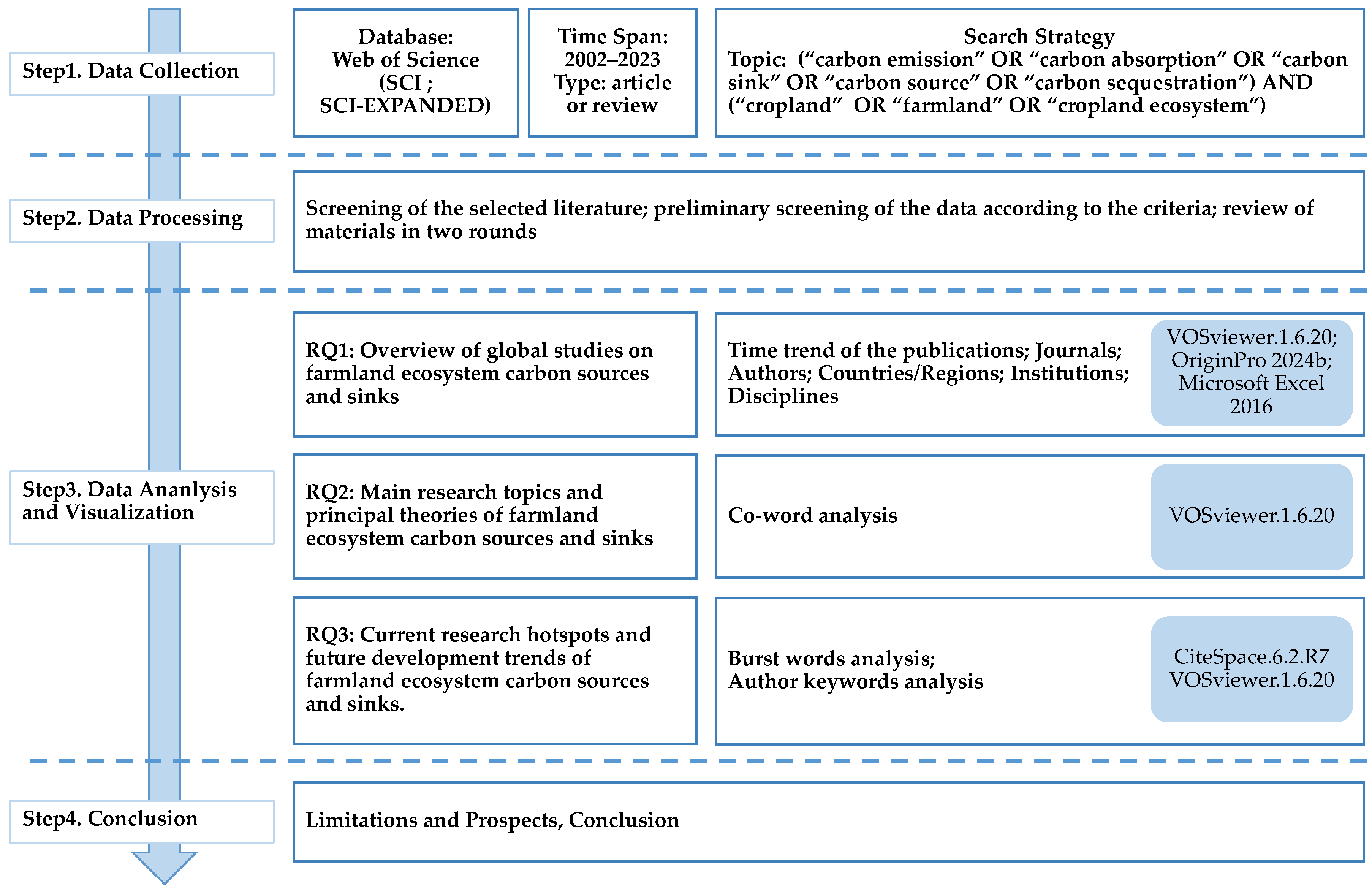
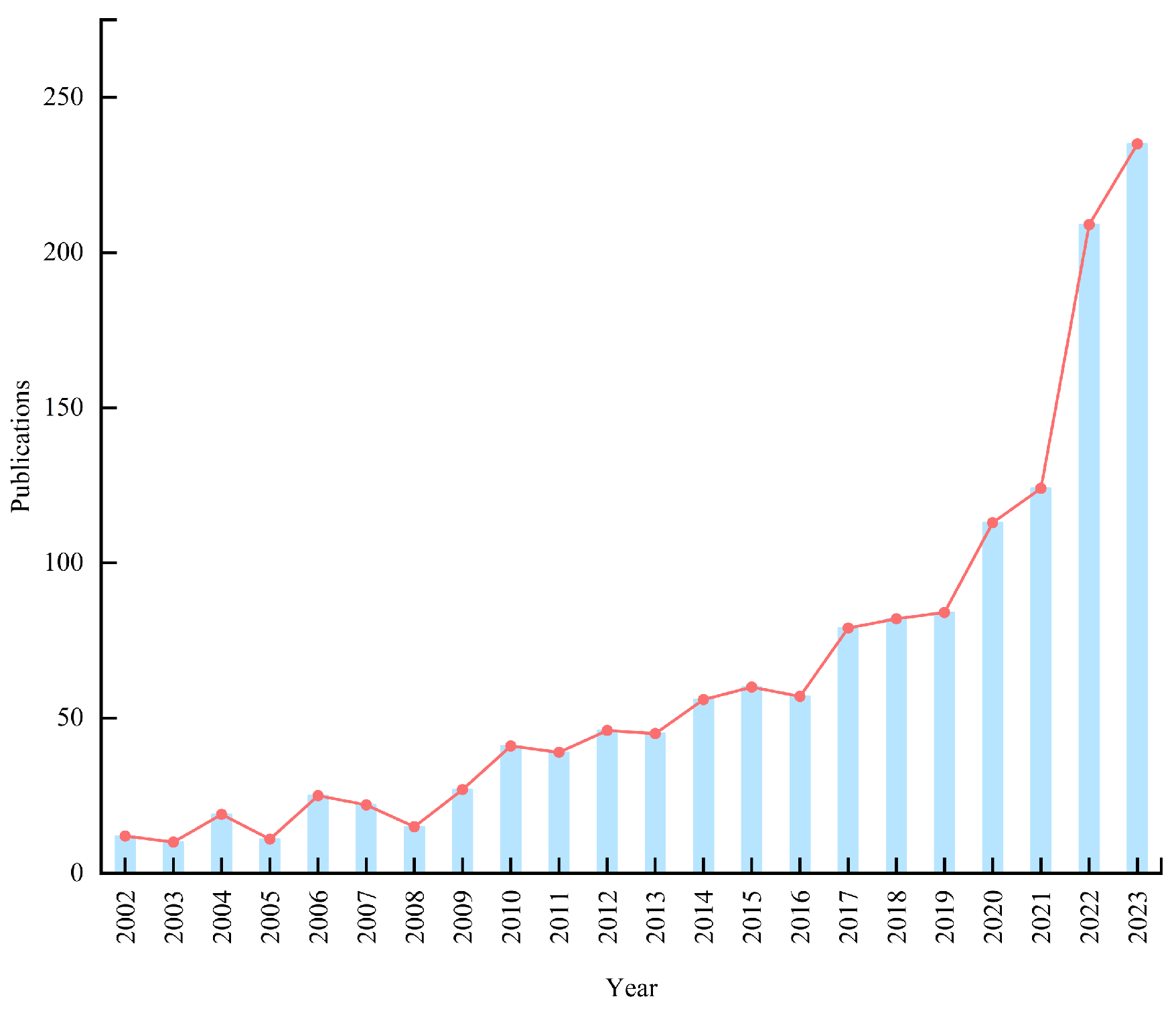
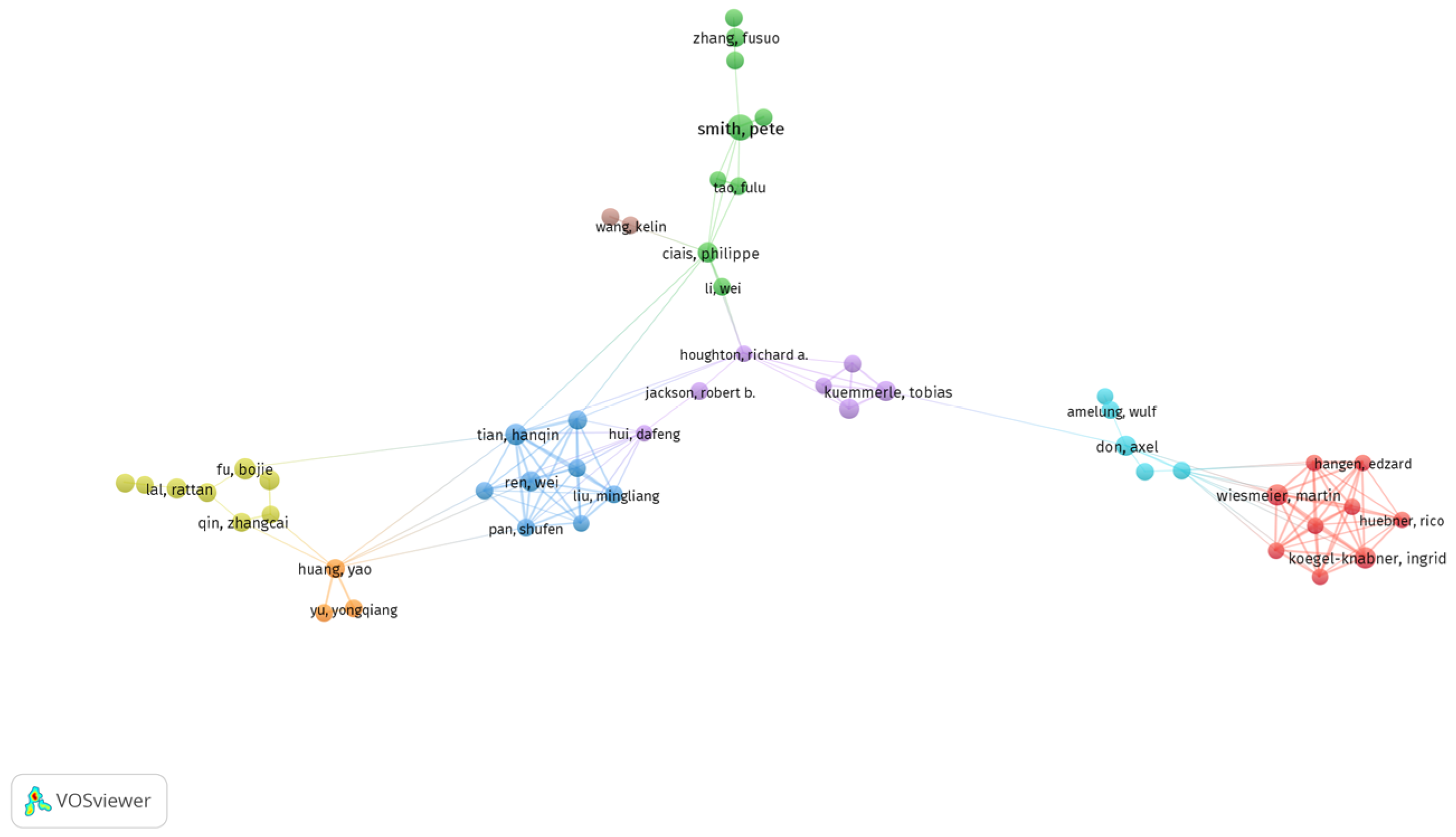


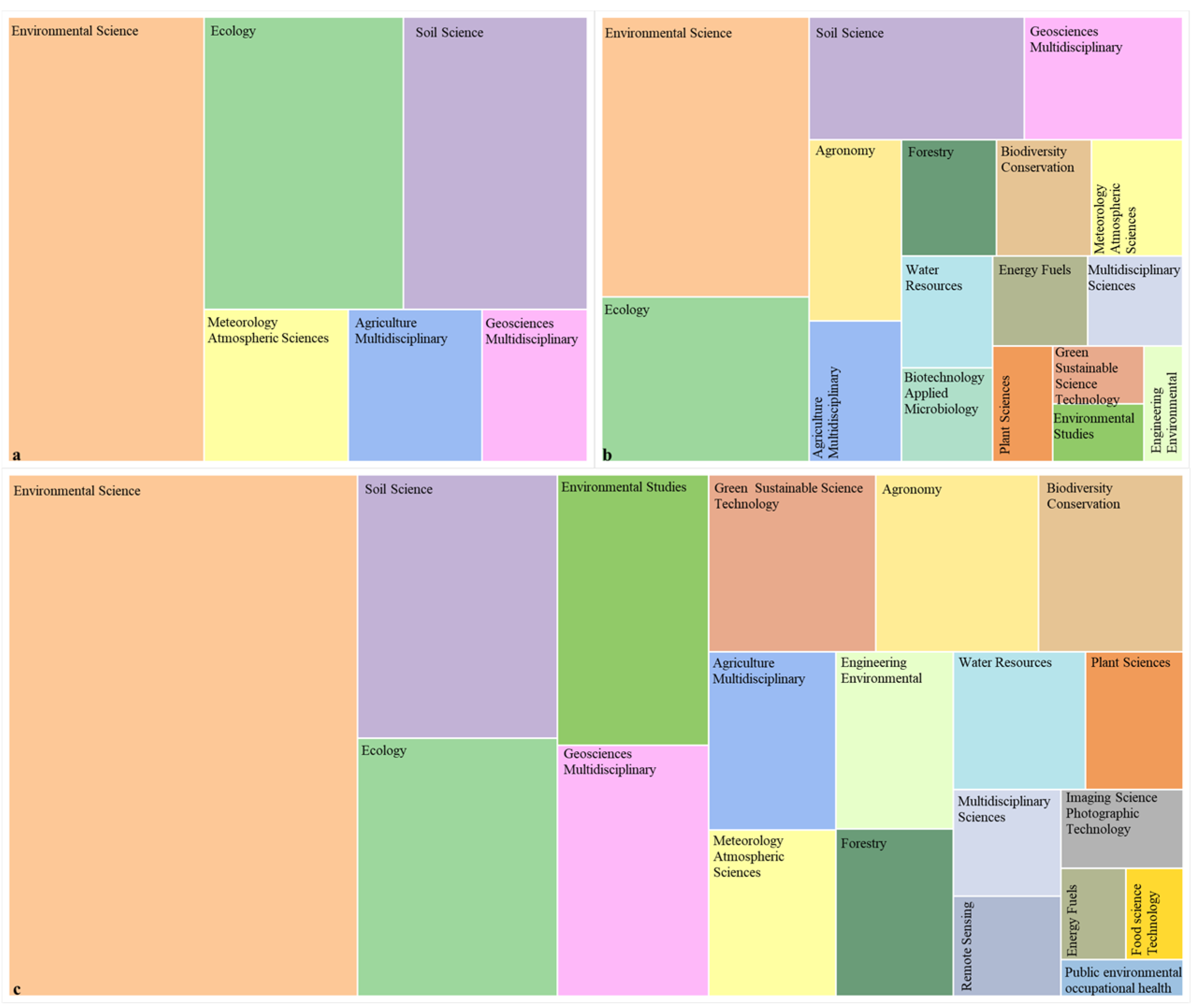
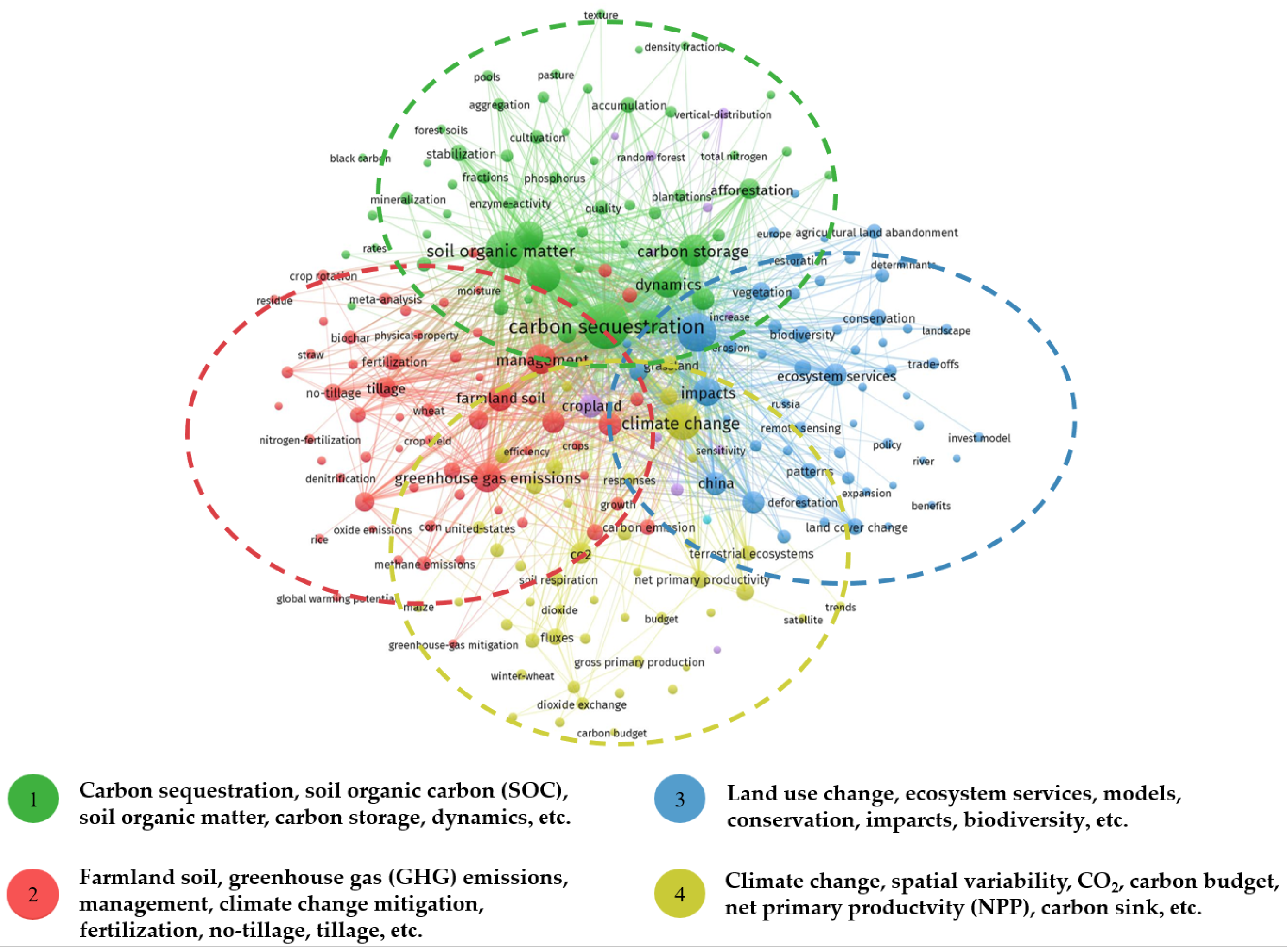
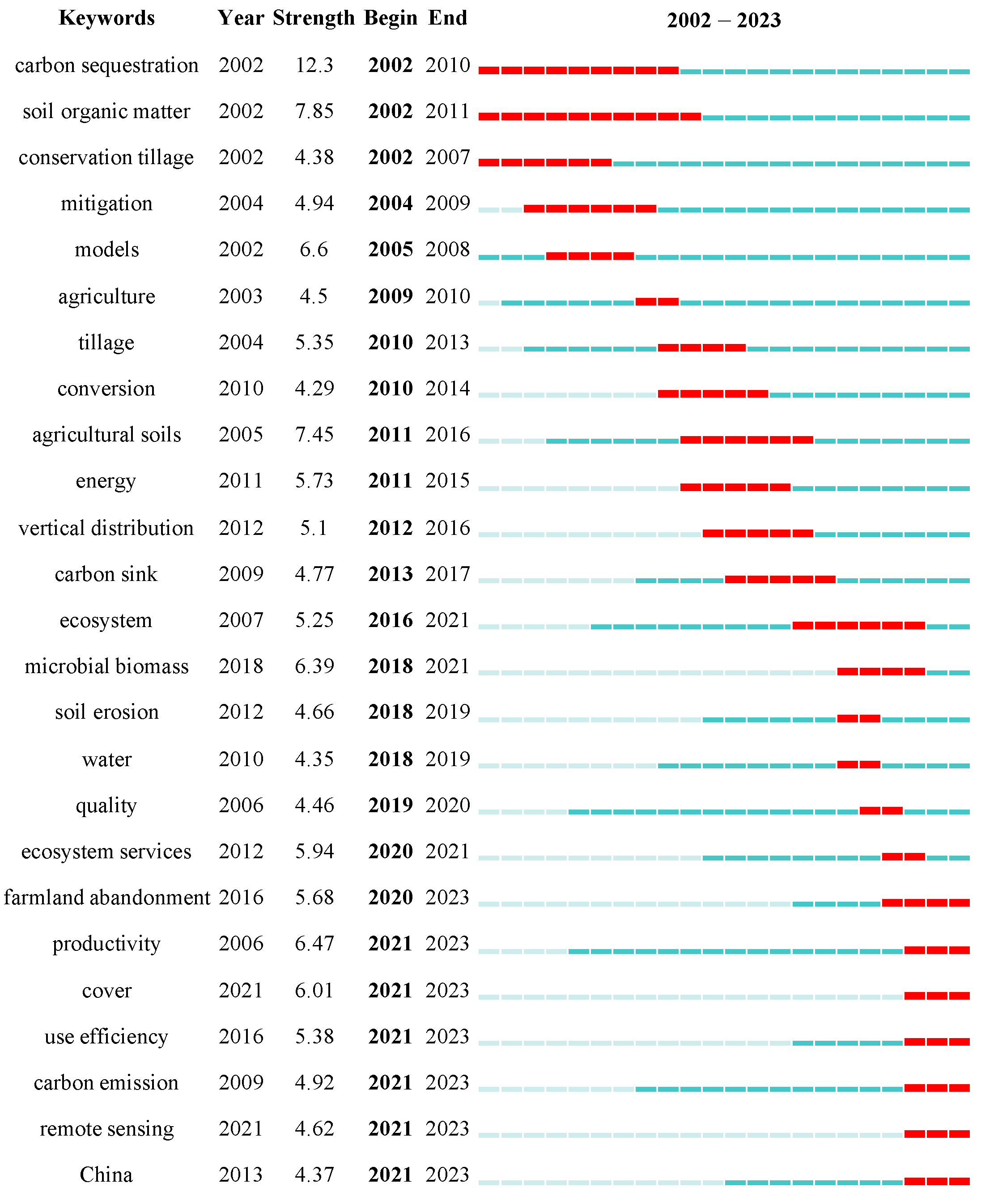

| Ranking | Journal | Number of Publications | Proportion of Publications (%) | Total Citations |
|---|---|---|---|---|
| 1 | Science of the Total Environment | 93 | 6.59 | 2800 |
| 2 | Agriculture Ecosystems & Environment | 74 | 5.24 | 4903 |
| 3 | Global Change Biology | 56 | 3.97 | 8270 |
| 4 | Catena | 43 | 3.05 | 1203 |
| 5 | Journal of Cleaner Production | 40 | 2.83 | 939 |
| 6 | Ecological Indicators | 39 | 2.76 | 1375 |
| 7 | Land | 35 | 2.48 | 168 |
| 8 | Sustainability | 34 | 2.41 | 360 |
| 9 | Geoderma | 31 | 2.20 | 1434 |
| 10 | Land Degradation & Development | 30 | 2.13 | 1197 |
| Author | Number of Publications | Total Citations in the Literature | Average Year of Publication |
|---|---|---|---|
| Smith, Pete | 20 | 2824 | 2016 |
| Tian, hanqin | 12 | 870 | 2014 |
| Fu, bojie | 11 | 1473 | 2013 |
| Koegel-knabner, Ingrid | 11 | 821 | 2016 |
| Wiesmeier, Martin | 11 | 828 | 2017 |
| Ciais, Philippe | 10 | 582 | 2020 |
| Deng, Lei | 10 | 1054 | 2016 |
| Don, Axel | 10 | 916 | 2018 |
| Kuemmerle, Tobias | 10 | 1054 | 2015 |
| Prishchepov, alexander V. | 10 | 643 | 2017 |
| Method | Advantages | Shortcomings | Scale | Applications |
|---|---|---|---|---|
| Measurement method | ① Easy to operate; ② results are precise and reliable. | ① Data acquisition challenges; ② expensive human and material resources; ③ vulnerability. | Microscopic | Microscopic or simple ecosystem. |
| Emission factor method | ① Easily operated and understood; ② established accounting formulas, activity data, and emission factor databases are available; ③ straightforward data collection. | Lack of capacity for emission system changes. | Macroscopic; mesoscopic; microscopic | Socioeconomic emission sources; typically complex or simplified natural emission sources or carbon sinks. |
| Mass balance method | Clearly distinguishes between emission sources. | ① Cumbersome intermediate procedures for emissions to be taken into account; ② prone to systematic errors; ③ obtaining data is difficult. | Macroscopic; mesoscopic | Emission equipment is frequently updated and highly precise; natural emission sources are complex. |
| Life cycle method | Assesses the total GHG emissions arising from all activities and inputs across the full life cycle of a production or consumption process. | Cumbersome process. | Mesoscopic; microscopic | Features a relatively complete and systematic production process. |
| Modeling method | ① Quantitatively distinguishes the contribution of different factors to changes in carbon sources and sinks; ② predicts future changes in carbon sources and sinks; ③ reflects the material cycling processes of ecosystems. | ① Complex model structure with difficult parameter adjustments; ② limited or simplified consideration of ecosystem management’s impact on carbon cycling processes; ③ many models neglect lateral carbon transfer processes, such as watershed transport. | Macroscopic; mesoscopic; microscopic | Large regions, various administrative divisions, field scales, and multi-scale ecosystems. |
Disclaimer/Publisher’s Note: The statements, opinions and data contained in all publications are solely those of the individual author(s) and contributor(s) and not of MDPI and/or the editor(s). MDPI and/or the editor(s) disclaim responsibility for any injury to people or property resulting from any ideas, methods, instructions or products referred to in the content. |
© 2025 by the authors. Licensee MDPI, Basel, Switzerland. This article is an open access article distributed under the terms and conditions of the Creative Commons Attribution (CC BY) license (https://creativecommons.org/licenses/by/4.0/).
Share and Cite
Pang, Y.; Zhang, M.; Zhong, H.; Cevin, T.; Sun, C.; Zhang, S.; Li, X.; Dai, J.; Liu, C.; Zhang, C. Current Progress and Future Trends in Carbon Sources and Sinks in Farmland Ecosystems: A Bibliometric Analysis (2002–2023). Biology 2025, 14, 365. https://doi.org/10.3390/biology14040365
Pang Y, Zhang M, Zhong H, Cevin T, Sun C, Zhang S, Li X, Dai J, Liu C, Zhang C. Current Progress and Future Trends in Carbon Sources and Sinks in Farmland Ecosystems: A Bibliometric Analysis (2002–2023). Biology. 2025; 14(4):365. https://doi.org/10.3390/biology14040365
Chicago/Turabian StylePang, Yugong, Menghao Zhang, Hesen Zhong, Tibihenda Cevin, Chuanzhun Sun, Shoutao Zhang, Xinyu Li, Jun Dai, Chengshuai Liu, and Chi Zhang. 2025. "Current Progress and Future Trends in Carbon Sources and Sinks in Farmland Ecosystems: A Bibliometric Analysis (2002–2023)" Biology 14, no. 4: 365. https://doi.org/10.3390/biology14040365
APA StylePang, Y., Zhang, M., Zhong, H., Cevin, T., Sun, C., Zhang, S., Li, X., Dai, J., Liu, C., & Zhang, C. (2025). Current Progress and Future Trends in Carbon Sources and Sinks in Farmland Ecosystems: A Bibliometric Analysis (2002–2023). Biology, 14(4), 365. https://doi.org/10.3390/biology14040365







